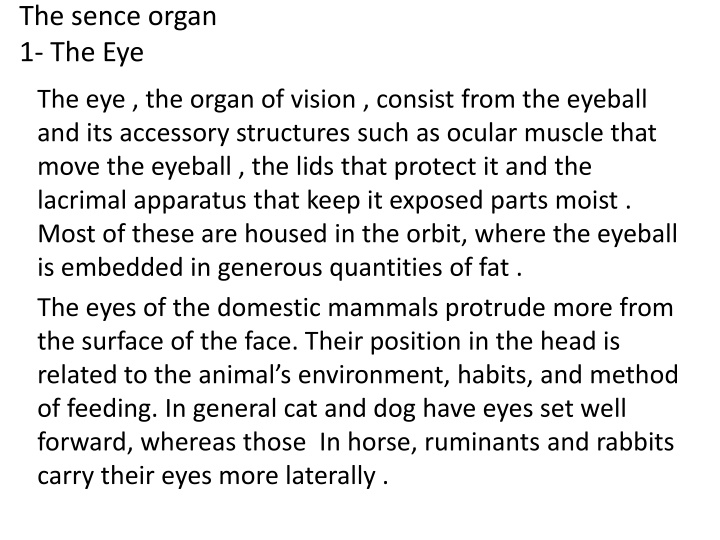
Anatomy of the Eye in Domestic Mammals
Explore the intricate anatomy of the eye in domestic mammals, including details on the eyeball structure, tunica layers, and functions of the middle vascular tunica. Learn about the positioning of eyes in different animals and their adaptations to their environments.
Download Presentation

Please find below an Image/Link to download the presentation.
The content on the website is provided AS IS for your information and personal use only. It may not be sold, licensed, or shared on other websites without obtaining consent from the author. If you encounter any issues during the download, it is possible that the publisher has removed the file from their server.
You are allowed to download the files provided on this website for personal or commercial use, subject to the condition that they are used lawfully. All files are the property of their respective owners.
The content on the website is provided AS IS for your information and personal use only. It may not be sold, licensed, or shared on other websites without obtaining consent from the author.
E N D
Presentation Transcript
The sence organ 1- The Eye The eye , the organ of vision , consist from the eyeball and its accessory structures such as ocular muscle that move the eyeball , the lids that protect it and the lacrimal apparatus that keep it exposed parts moist . Most of these are housed in the orbit, where the eyeball is embedded in generous quantities of fat . The eyes of the domestic mammals protrude more from the surface of the face. Their position in the head is related to the animal s environment, habits, and method of feeding. In general cat and dog have eyes set well forward, whereas those In horse, ruminants and rabbits carry their eyes more laterally .
The eyeball The eyeball of the domestic mammals is spherical with some anteroposterior compression in horses and cattle . The eyeball has three thin tunica , that surrounds the partly liquid , partly gelatinous centre . The three tunica are :- 1- An externals fibrous layer for protection the eyeball , it s the only complete tunica Consist of two segments of two spheres that differ in sizes. A- The Sclera- - . |The larger segment of the larger sphere , and appears superficially as the (white of the eye) as it is formed of collagen fibers with some elastic fibers . The ocular muscle are inserted to the external surface of the sclera . B - Cornea : The smaller segment of the smaller sphere . It forms the transparent anterior portion of the eye. It has no blood vessels except at its periphery . At the caudo ventral part of the fibrous layer , the optic nerve pierces the sclera . The two segments are connected at the corneo scleral junction (limbus) .
2- Middle vascular tunica that consist largely of blood vessels and smooth muscle and is concerned with the nutrition of the eyeball and regulation of the shape of the lens and size of the pupil . It consist of :- A- Choroid : Dark brown membrane attached to the sclera by connective tissue . It has light reflecting area .
B- Ciliary body : It is a black pigmented body that appears to surround the lens , its function is represented in changing the shape of the lens that give the eye the ability to focus on near or distance objects . C- Iris ( ) : composed of a flat ring of the tissue attached at its periphery to the sclera and the ciliary body ; the opening in the centre is the pupil through which light enters to the eye , that regulated by smooth muscle fibers .
3- An internal nervous tunica that consist largely of nervous tissue and directly concerned with the vision . Focusing Light The lens is a transparent structure located behind the iris and held in place by ligaments. The animal uses the lens to focus on nearby objects. Posterior Segment or Fundus Vitreous chamber--This is the large space between the lens and retina that contains the very thick vitreous.
3 - Retina--The retina is the most complex structure of the eye and is the most metabolically active tissue in the body. It converts light energy into chemical energy to generate the electrical signal that is conducted to the brain in order for the vision . The retina contains a high number of very large ganglion cells that conduct the visual impulses quickly.
